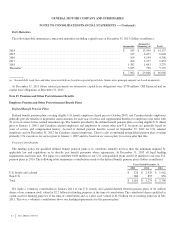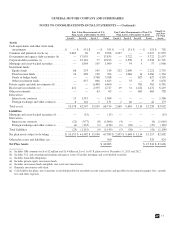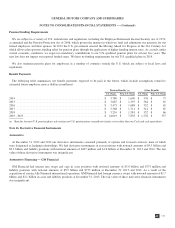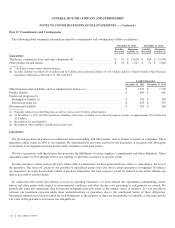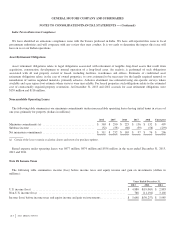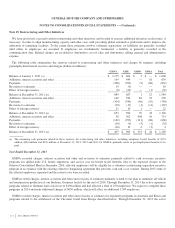General Motors 2013 Annual Report Download - page 104
Download and view the complete annual report
Please find page 104 of the 2013 General Motors annual report below. You can navigate through the pages in the report by either clicking on the pages listed below, or by using the keyword search tool below to find specific information within the annual report.
GENERAL MOTORS COMPANY AND SUBSIDIARIES
NOTES TO CONSOLIDATED FINANCIAL STATEMENTS — (Continued)
arbitrage funds invest in a variety of credit and credit-related instruments that allow fund managers to profit from mispricing of these
credit instruments. Certain derivatives may be used for hedging purposes by some fixed income fund managers to limit exposure to
various risk factors.
Funds of hedge funds represent funds that invest in a portfolio of hedge funds. Fund managers typically seek to achieve their
objectives by allocating capital across a broad array of funds and/or investment managers.
Other investment funds primarily represent multi-strategy funds. These funds invest in broadly diversified portfolios of equity,
fixed income and derivative instruments. Certain funds may also employ multiple alternative investment strategies, in combination,
such as global macro, event-driven (which seeks to profit from opportunities created by significant transactional events such as spin-
offs, mergers and acquisitions, bankruptcy reorganizations, recapitalizations and share buybacks) and relative value (which seeks to
take advantage of pricing discrepancies between instruments including equities, debt, options and futures).
Private equity and debt investments principally consists of investments in private equity and debt funds. These investments provide
exposure to and benefit from long-term equity investments in private companies, including leveraged buy-outs, venture capital and
distressed debt strategies.
Real estate investments include funds that invest in entities which are principally engaged in the ownership, acquisition,
development, financing, sale and/or management of income-producing real estate properties, both commercial and residential. These
funds typically seek long-term growth of capital and current income that is above average relative to public equity funds.
Significant Concentrations of Risk
The assets of the pension plans include certain private investment funds, private equity and debt securities, real estate investments
and derivative instruments. Investment managers may be unable to quickly sell or redeem some or all of these investments at an
amount close or equal to fair value in order to meet a plan’s liquidity requirements or to respond to specific events such as
deterioration in the creditworthiness of any particular issuer or counterparty.
Illiquid investments held by the plans are generally long-term investments that complement the long-term nature of pension
obligations and are not used to fund benefit payments when currently due. Plan management monitors liquidity risk on an ongoing
basis and has procedures in place that are designed to maintain flexibility in addressing plan-specific, broader industry and market
liquidity events.
The pension plans may invest in financial instruments denominated in foreign currencies and may be exposed to risks that the
foreign currency exchange rates might change in a manner that has an adverse effect on the value of the foreign currency denominated
assets or liabilities. Forward currency contracts may be used to manage and mitigate foreign currency risk.
The pension plans may invest in fixed income securities for which any change in the relevant interest rates for particular securities
might result in an investment manager being unable to secure similar returns upon the maturity or the sale of securities. In addition,
changes to prevailing interest rates or changes in expectations of future interest rates might result in an increase or decrease in the fair
value of the securities held. Interest rate swaps and other financial derivative instruments may be used to manage interest rate risk.
Counterparty credit risk is the risk that a counterparty to a financial instrument will default on its commitment. Counterparty risk is
primarily related to over-the-counter derivative instruments used to manage risk exposures related to interest rates on long-term debt
securities and foreign currency exchange rate fluctuations. The risk of default can be influenced by various factors including macro-
economic conditions, market liquidity, fiscal and monetary policies and counterparty-specific characteristics and activities. Certain
agreements with counterparties employ set-off, collateral support arrangements and other risk mitigating procedures designed to
reduce the net exposure to credit risk in the event of counterparty default. Credit policies and processes are in place to manage
concentrations of counterparty risk by seeking to undertake transactions with large well-capitalized counterparties and by monitoring
the creditworthiness of these counterparties. The majority of derivatives held by the plans at December 31, 2013 were fully
collateralized and therefore, the related counterparty credit risk was significantly reduced.
102
2013 ANNUAL REPORT


